
|
Sale 66
The Manuscript, Space, Stamp & Collectibles Auction
| Colonial and Revolutionary America |
| |
| |
| Lot |
Photo |
Description |
Realized |
Lot 82 |
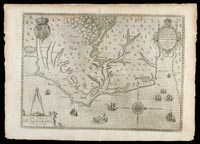 |
Americae pars, Nunc Virginia dicta - 1590 White De Bry Map of Virginia, "Americae pars, Nunc Virginia dicta primum ab Anglis inuenta sumtibus Dn. Walteri Ralegh…." ("Part of America, now called Virginia, first discovered by the English, taken up by Sir Walter Ralegh, Knight, in 1585 A.D., in the twenty-seventh [year] of the reign of our most serene Queen Elizabeth; the history whereof is truly described by this special book and also by the images of the natives included.") Engraved by Theodore De Bry, based on John White's 1585 map. Published with Thomas Harriot's A Briefe and True Report of the New Found Land of Virginia in Vol. 1 of Theodore de Bry's Great Voyages. Map is 12 x 16 inches; sheet is 14¼ x 19¼ inches. Burden described this map as "one of the most significant cartographical milestones in colonial North American history. It was the most accurate map drawn in the sixteenth century of any part of that continent. It became the prototype of the area until long after James Moxon's map in 1671."
This was the first printed map to focus on Virginia, and the first to name Chesapeake Bay and Roanoke. It records the earliest English attempts at colonization in the New World, depicting the Virginia area before the calamitous end of the original Roanoke colony in 1590. The area shown is from Cape Lookout to the Chesapeake; many of the parts depicted are now North Carolina.
This map is in its original condition, with full, original, broad margins. It is lightly toned but has never been cleaned, bleached, or relined. With decorative cartouches for the title, the motto of the British Order of the Garter ("Honi soit qui mal y pense"), and the scale of leagues. A small cartouche at left says, "Autore Ioanne With / Sculptore Theodore de / Bry, Quiet excud." Numerous ships fill the water, as well as a wind rose and a sea creature with two spout holes. There are several small depictions of Indians in canoes and on land. Truly one of the finest examples extant.
Estimated Value $18,000 - 22,000,
Ex Clive Burden,
View details and enlarged photo
| Unsold |
Lot 83 |
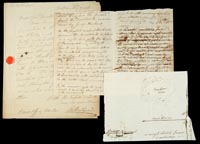 |
[Bunker Hill] Henry Dearborn Answers Questions & Sketches the Battle (1751-1829) Physician, statesman, and veteran of the American Revolutionary War and the War of 1812. Holograph sketch of the Battle of Bunker Hill drawn by Major General Henry Dearborn, who was among the men of John Stark's regiment who fought at the rail fence during the Battle of Bunker Hill. Responding to a request from L.C. Ballard of Boston in 1818 (letter is present), Dearborn drew "a rough sketch from recollection" on 5½ x 7 inch paper. The sketch shows "Bunkers Hill," the famous rail fence along which the Americans were able to retreat and which prevented the encirclement of the hill, Breeds Hill, with a box around the "Red[oub]t, the British to its left and Breastwork to the right. The Mystic River is at the far right of the sketch.
Gen. Dearborn also writes two holograph pages, 7 x 5 inches, on pages three and four of a bifolium, answering questions posed by a Mr. Child on the first two pages, such as what the distinction was between the redoubt and the little fort near it, and if it was certain that the British kept firing as they advanced the second time and that they had no intention to attack with the bayonet at that time. Because of ink bleeding, Dearborn's writing is difficult to read, but he answers the first question at length, then writes, in part, "The fire from the British Troops commenced each time about the same time that the fire commenced from the Redoubt & rail fence…There was no appearance of any intention to use the bayonet until the reinforcements arrived & marched directly to the Southern angle of the redoubt &…carried the redoubt by assault with the bayonet." This lot includes three items: Dearborn's sketch, his two-page holograph reply, and the Nov. 9, 1818 letter from Mr. Ballard to General Dearborn. We have never before seen a sketch of Bunker Hill drawn by a participant in that battle.
Estimated Value $2,000 - 3,000,
Paul Richards, 1982,
View details and enlarged photos
| Realized
$7,800 |
Lot 84 |
 |
1679 Power of Attorney by an Early Settler of Pemaquid, Document signed by Sylvanus Davis, June 9, 1679, one page, 13 x 8¼ inches, Boston, New England, Granting power of attorney to John Morrell, currently at Piscattaway (Maine), New England, to carry out any collection of money on behalf of Davis, as if he were personally present to do the same. Signed at the bottom by Sylvanus Davis with his red wax seal and witnessed by William Kent and Thomas Kemble. Fold wear and edge faults affect a few words of text, else in overall very good shape for such an early Boston document.
Born in 1635, Sylvanus Davis was one of the early settlers of ancient Pemaquid and later of Falmouth, now Portland, Maine. He is first reported as buying land from the Indians in ancient Pemaquid up the Damariscotta River in June of 1659; he bought more land from the Indians in 1665 and 1694, as well as from other settlers; he also received land grants from the colonial government. Davis established himself as a coastal trader, harvested timber from the Norumbega tidewater and brought this timber to Portland, Boston and other coastal communities until the beginning of the Indian Wars in 1676. After 1673, Davis was an agent for the Clark and Lake Company on Arrowsic Island and was there in 1676 when the Indians attacked the Clark and Lake settlement and fort at the southeasterly point of the island. He was badly wounded but managed to escape, as noted in The History of the State of Maine by Williamson. Davis is listed in Noyes ' Genealogical Dictionary of Maine and New Hampshire.
Estimated Value $400 - 600
View details and enlarged photo
| Realized
$552 |
Lot 85 |
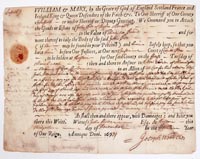 |
1693 Boston Warrant, Partly-printed document issued in the name of William and Mary and signed by clerk Joseph Webb, one page, 7 x 9 inches, Boston, Dec. 30, 1693, Boston, Massachusetts. Ordering the sheriff of Suffolk County to attach the goods or estate of John Poole for the value of 36 pounds or to take him into custody and hold him to appear before the next Inferior Court of Common Pleas to answer the complaint of Robert Warren of Manchester, Massachusetts. It seems Poole hired John Cole, under the command of John Pascoe, to go to Newfoundland on a fishing expedition which lasted from March 1692 to August 1693 and Poole refused to pay the eighteen pounds justly due Mr. Cole. Deputy Sheriff Jacob Amsden signed on the verso that he received a bond from Poole, who would appear in court. Minor damp staining, else in overall good condition. Joseph Webb was clerk of the county court of Suffolk 1689-1692, and of the Inferior Court 1692-1698. John Poole, son of William, married Elizabeth (1677), daughter of Governor Brenton, and died in 1711.
Estimated Value $400 - 600
View details and enlarged photo
| Realized
$300 |
Lot 86 |
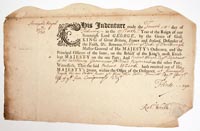 |
1719/20 Receipt For 190 Flints For Governor Phillips' Regiment, Partly-printed document signed by Robert Wroth, "adjutant of His Excellency Governour Phillips's Regiment," one page, 8 x 12¾ inches, February 4, 1719/20, Annapolis Royal (Port Royal, Nova Scotia). An indenture between "His Grace ye Duke of Marlbrough Master General of His Majesty'[s Ordnance…and Robert Wroth…Witnesseth, That the said Robert Wroth hath received out of His Majesty's Stores within the Office of the Ordnance, at Annapolis Royal by an Order from ye Honable John Doucett Esqr. for ye Use of ye five Companys Vizt Flints…190." A scarce Annapolis Royal document.
Annapolis Royal, originally Port-Royal, was settled by the French in 1605. It was the first European settlement in Canada, settled three years before Quebec City and two years before Jamestown, Virginia. It became Annapolis Royal (after Queen Anne) when the British took sovereignty of Nova Scotia from the French in 1710. It was the capital of Nova Scotia from 1713 to 1749. The defeat of Port Royal in 1710 marked the final conquest of Acadia by the British. Under the Treaty of Utrecht in 1713, Acadia was granted to the British; however, the vague boundary definitions saw only the peninsular part of Nova Scotia granted to Britain, and the next half century would be turbulent years as Britain and France acted out the final struggle for Acadia and North America.
Estimated Value $600 - 800
View details and enlarged photo
| Realized
$720 |
Lot 87 |
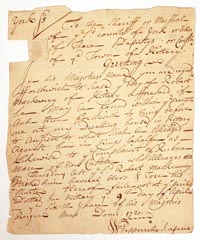 |
1720 Maine Warrant Signed by William Pepperell, Manuscript document signed by William Pepperell as Justice of the Peace, one page, 7½ x 6¼ inches, York County (Maine), April 9, 1720. Ordering the sheriff or marshal of York County or the constable of the town of Kittery to seize the body of Robert Mackenney to answer a charge from Reuben Mace of New Castle. The charge states that Mackenney struck Mace several blows and tore his shirt. Constable Robert Mitchel signs on the verso that he has done as commanded. Overall fine condition.
Born around 1646 in England, Pepperell came to America at the age of 22 and within a few years was the owner of a large mercantile fleet of ships. He became Justice of the Peace in 1690 and held that office for 35 years. He was appointed Judge of the Court of Common Pleas in 1715 and served on the bench many years. He commanded the garrison at Fort Pepperell, Kittery Point, at a period when Indian hostilities prevailed, and bore the rank of Captain. In the Militia he held the same rank, and before his death had risen to the rank of Lieutenant-Colonel.
Estimated Value $400 - 600
View details and enlarged photo
| Realized
$300 |
Lot 88 |
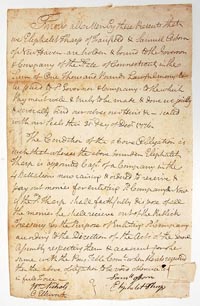 |
1776 Connecticut Bond to Raise a New Regiment in the 4th Battalion, Document signed by Oliver Ellsworth, William Nichols, Eliphalet Tharpe and Samuel Osborn, one page, 11 x 6¾ inches, n.p., Dec. 31, 1776. Tharp and Osborn "are holden & bound to the Governor & Company of the State of Connecticut in the Sum of One Thousand Pounds Lawful mony…the above bounden Eliphalet Thorp is appointed Capt. of a Company in the 4 Battalion now raising & ordered to receive & pay out monies for enlisting…." Light toning, else fine. Very bold signatures.
Oliver Ellsworth (1745-1807) was a drafter of the United States Constitution, and the third Chief Justice of the United States. He and William Nichols were members of the Connecticut Pay Table. Eliphalet Thorp was commissioned captain, 1776, of the 4th company, 4th regiment of militia.
Estimated Value $300 - 500
View details and enlarged photo
| Realized
$420 |
Lot 89 |
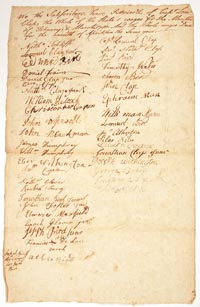 |
1780 Payroll From Capt. Clapp's Company - With Seven Minutemen, Manuscript document signed by the enlisted men in Captain Lemuel Clapp's Company, Dorchester, Massachusetts, 13 x 8¼ inches, 1780. The men acknowledge receipt "of Captain Lemuel Clapp, the whole of the State's Wages for the months of February and March 1780, and the whole of the wages due for the month of April for the same year." A scarce military payroll, with seven minutemen (denoted by an "M") who were members of the Dorchester company which assembled on April 19, 1775, the day of the battle of Lexington. Overall very good condition.
The men are: Capt. Lemuel Clapp (M), Nathaniel Topliff, Lemuel Clapp Jr., Lt. Nathaniel Clapp (M), Edward Wiswell, Lt. Bird, Daniel Fairne (M), Timothy Wales, David Clapp Jr., Aaron Bird, Ezra Clapp (M), John Clapp, William Bullock, Ephraim Mann, Christopher Capen, William Mann, John Wiswell Lemuel Clapp, John Blackman, John Atherton (M), James Humphrey, Silas Niles, William Humphrey, Jonathan Clapp Jr., Ebenezer Withington, Joseph Withington (M), John Capen George Baker, Nathaniel Glover, Jonathan Bird (M), Reuben Torrey, Thomas White, Jonathan Bird Jr., Enoch Glover Jr., John Foster, Jr., Joseph Bird Jr., Ebenezer Maxfield (M), and Francis De Luce (M).
Estimated Value $800 - 1,000
View details and enlarged photo
| Realized
$1,680 |
Lot 90 |
 |
1780 Revolutionary War Orders for Cambridge, Massachusetts, Manuscript document signed by Thomas Farrington, town clerk of Cambridge, one page, 9 x 7 inches, Dec. 15, 1780. To Thomas Thwing, constable of Cambridge, requiring him "to warn all the Inhabitants in the South Precinct in sd. Town qualified to vote in Town affairs to assemble at the Court House in Cambridge" on December 18th. They were to vote on the following: The number of men required in the Army as referenced by the General Assembly; supplying the Army with 35,255 lbs of beef; if they would instruct their Representatives regarding a tender Act; laying before the Town the accounts of the members of Convention for framing a Constitution or frame of Government and for regulating prices on various articles. Constable Thomas Thwing signs on the verso that he has warned all freeholders of the upcoming meeting time and place. Small area of paper loss at lower right (about 1 x 1 inch) affecting a few words of text, small archival repair on verso, else a scarce document in overall very good shape.
The Constitution of the Commonwealth of Massachusetts was drafted by John Adams, Samuel Adams, and James Bowdoin during the Massachusetts Constitutional Convention between September 1 and October 30, 1779. Following approval by town meetings, the Constitution was ratified on June 15, 1780 and became effective on October 25, 1780. It remains the oldest functioning written constitution in continuous effect in the world.
Estimated Value $400 - 600
View details and enlarged photo
| Realized
$1,050 |
Lot 91 |
 |
1780 State of Virginia Promissory Note to A Soldier, Partly-printed Document Signed by George Brooke, Treasurer of the Commonwealth of Virginia, 7¼ x 7 inches, n.p., Jan. 11, 1780. Acknowledging receipt of "three hundred eighty and one third Dollars from the Executors of Richard Parker." Decorative border. One split at bottom center and minor pinholes at folds, else fine. Richard Parker was Captain 2d Virginia Regiment in 1775; Major 6th Virginia Regiment in 1776; Lt-Col. 2d Virginia Regiment in 1777; and Col. 1st Virginia Regiment in 1778. He died April 24, 1780, of wounds received at the siege of Charleston. Col. George Brooke was a Colonel in the Virginia State line three years. He was also a member of the House of Burgesses (1768-1776), in the Virginia Conventions (1775-76), a member of the Council of Safety, King and Queen County (1775), and Treasurer of Virginia (1781-1782).
Estimated Value $400 - 600
View details and enlarged photo
| Realized
$3,840 |
Lot 92 |
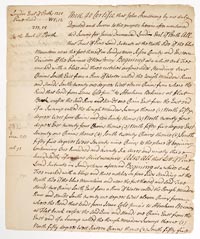 |
Alexander, William, Lord Stirling (1726-83) American Revolutionary War officer. After the Battle of Monmouth, he presided over the court-martial trial of General Charles Lee, with whom he had cooperated in preparing the defense of New York. Manuscript Document Signed ("Stirling"), two pages, 9¼ x 7¾ inches, New Jersey, Sept. 20, 1773. Certifying that "John Armstrong…did Survey for James Drummond Lundin Earl of Perth all that Tract of Pine Land scituate at the north side of the blue mountain near the foot thereof in Sandystown Sussex County and Easton Division of the Province of New Jersey…." One clean separation, easily repaired, at bottom fold, not affecting Stirling's signature or paraph. The self-styled Lord Stirling was a wealthy man and lived on an estate in Basking Ridge, New Jersey. At the outbreak of the American Revolution, he was appointed a colonel in the New Jersey militia, which he outfitted at his own expense.
Estimated Value $500 - 600,
Joe Rubinfine, 1978,
View details and enlarged photos
| Realized
$2,160 |
Lot 93 |
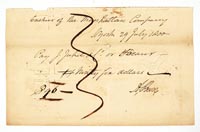 |
Burr, Aaron (1756-1836) Revolutionary War officer, Vice President under Thomas Jefferson; best known for killing Alexander Hamilton in a duel in 1804. Autograph Document Signed ("A. Burr"), 4½ x 7 inches, New York, July 29, 1800. A payment draft addressed to the Cashier of the Manhattan Company,"to pay J. (John) Jukel & Co. or Bearer the sum of ninety-six dollars. The draft is cancelled. Boldly penned and signed. Overall very good.
In 1799, Burr founded the Bank of the Manhattan Company, which in later years was absorbed into the Chase Manhattan Bank, which in turn became part of JPMorgan Chase. On April 17, 1799, the Manhattan Company appointed a committee "to consider the most proper means of employing the capital of the Company" and elected to open an office of discount and deposit. The "Bank" of the Manhattan Company began business on September 1, 1799, at 40 Wall Street. The Bank started paying dividends in July 1800, the month this draft was written.
Estimated Value $600 - 800
View details and enlarged photo
| Realized
$780 |
Lot 94 |
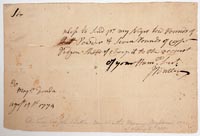 |
Butler, John (1728-1796) Wealthy Loyalist and Indian agent who led a regiment known as Butler's Rangers; he is most remembered for the Wyoming Valley massacre of July 1778, where his rangers and Iroquois allies, after defeating Zebulon Butler and taking Forty Fort, were said to have executed and scalped prisoners and fleeing enemy soldiers. Because of this massacre and a massacre led by John's son, Walter, the same year (Cherry Valley massacre), the name "Butler" was much reviled on the northern frontier.
Autograph Document Signed ("J Butler"), 1 page, 5½ x 8¼, n.p., Aug. 15, 1779. Two weeks before the Battle of Newtown (August 29, 1779), an armed offensive led by General John Sullivan by order of the Continental Congress to end the threat of the Iroquois who had sided with the British, Butler orders nine pounds of powder and "shott" from Major Fonda to be sent "pr. my Negro." The British Loyalists and the Iroquois were defeated and Butler withdrew to Fort Niagara.
Estimated Value $400 - 600,
Joe Rubinfine, 1980,
View details and enlarged photo
| Realized
$1,200 |
Lot 95 |
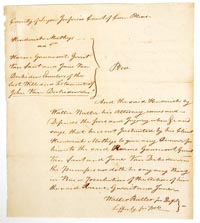 |
Butler, Walter (1752-81) Loyalist who became a captain in Butler's Rangers, formed by his father, John. He was probably the most hated Loyalist in America, not least because he commanded the Loyalist raiding party that attacked Cherry Valley on November 11, 1778, and butchered many women and children. He was captured in 1777 by Continental Army troops commanded by Lt. Col. Marinus Willett, but escaped after a few months. Ironically, it was Lt. Col. Willett, who, on October 30, 1781, came across Butler again while pursuing Major John Ross' forces after the Battle of Johnstown. Butler was shot and scalped by one of Willett's Indian allies. The news of his death caused great rejoicing in New York's Mohawk Valley.
Autograph Document Signed twice, once in the text and once at the end, as attorney for the defendant in a case before the County of Tryon Inferior Court of Common Pleas, 8½ x 7½ inches, n.p., n.d. Butler had studied law and practiced in Albany, New York, before the start of the American Revolution.
Estimated Value $1,000 - 1,250,
Joe Rubinfine, 1983,
View details and enlarged photo
| Realized
$1,800 |
Lot 96 |
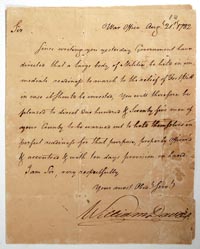 |
Davies, William, Revolutionary War-date Letter Signed as Virginia's Secretary of War, one page, 8 x 6¼ inches, War Office, Aug. 21, 1782. With orders to the Lieutenant or Commanding Officer of Berkley: "Since writing you yesterday Government have directed that a large body of Militia be held in immediate readiness to march to the relief of Fort Pitt in case it should be invested; You will therefore be pleased to direct one hundred & seventy five men of your County to be warned out to hold themselves in perfect readiness for that purpose, properly Officer'd & accoutred & with ten days provision on hand…." Letter is very good with one fold split; integral address leaf is fragile, with several splits.
Fort Pitt was headquarters of the Western Department and the gateway to the frontier. It had been the scene of conflict between the British and the French in the French and Indian War and remained a scene of conflict between the Americans and the British in the Revolution. To exacerbate matters, in March 1782, 160 militia members out of Fort Pitt marched to the outskirts of Goschochking and massacred 96 Indians, many of them converts of the Moravians, and many of them women and children. Protection for the Fort had to be increased in preparation for the expected revenge attack.
Estimated Value $600 - 800
View details and enlarged photo
| Realized
$1,920 |
Lot 97 |
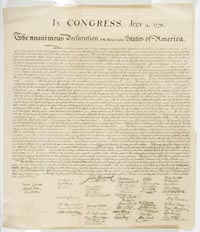 |
Declaration of Independence, Peter Force rice paper copy of the Declaration of Independence, 29¾ x 25½ inches. As expected, "W.J. Stone Sc. Washn." is engraved below the names of the three Signers in the first row on the left. This copy has light, even toning; archival repairs in blank lower left corner affect nothing; one small hole in the text affects a couple of letters; one clean 3" vertical split is barely visible and can be easily repaired. A lovely rice paper copy of the Declaration of Independence and an impressive display piece.
In 1823, William J. Stone was commissioned by Congress to create a copperplate from which facsimile copies of the Declaration could be made. He did this by wetting the original document and transferring some of the original ink to the copperplate. From this plate, Stone printed 201 copies on parchment, which were given to President James Monroe, original Signers, members of Congress, colleges and institutions, etc. Stone's personal copy is in the Smithsonian. Only 31 of Stone's original 201 copies are known to exist; nineteen of these reside in museums and examples are rarely offered for sale.
In 1843, Congress authorized Peter Force to make up to 1500 rice-paper copies of the Declaration from the original Stone copperplate, to be included in his nine-volume set of American Archives. Subscriptions were fewer than expected, and the actual number of copies printed is unknown, ranging from 500 to around 1,000. It is not known how many of these copies have survived and most of the Declarations have been removed from the volume in which they were folded.
Estimated Value $14,000 - 18,000
View details and enlarged photo
| Realized
$21,600 |
Lot 98 |
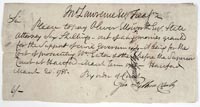 |
Ellsworth, Oliver (1745-1807) Delegate to Continental Congress and Constitutional Convention; Chief Justice of the U.S. (1796-1800). Document Signed ("O. Ellsworth") on the verso, 4 x 7¾ inches, Hartford, Mar. 20, 1785. A pay order directed to Connecticut treasurer John Lawrence to pay Ellsworth six shillings "for the cost of prosecuting Wm. Eaten & others before the Superior Court at Hartford--March term 1785…."
Estimated Value $150 - 200,
Superior Galleries, 1993,
View details and enlarged photo
| Unsold |
Lot 99 |
 |
[Franklin, Benjamin] David Hall, Two original documents signed by Franklin's partner David Hall (1714-1772), one being two pages, 14½ x 9 inches, February 3, 1766, the other one page, folio, January 1, 1771. These two 18th century printing contracts establish Hall & Sellers, which succeeded the printing business of Benjamin Franklin and David Hall. Some slight ink erosion and chipping affecting a few words; professionally strengthened at some folds.
In 1743 Benjamin Franklin hired David Hall, who had worked for Franklin's friend, William Strahan, in London, to assist him in his printing house. In a letter to Strahan a year later, Franklin remarked, "…Mr. Hall…gains ground daily in the esteem of all that know him…He is obliging, discreet, industrious, and honest." Franklin took Hall into partnership in 1748 and the enterprise became Franklin & Hall; on February 1, 1766 Franklin sold his interest in the most important printing business in the colonies to David Hall.
William Sellers had been Hall's journeyman in the printing house. Upon his purchase of this lucrative printing business from his mentor Benjamin Franklin, Hall immediately took Sellers in as a partner, creating the new firm of Hall & Sellers, the most significant printing establishment in the colonies. In addition to printing all the paper money for the colony of Pennsylvania, Hall & Sellers continued the contract with the state that Franklin had negotiated which included all pamphlets, and official documents.
The two documents offered here are the original partnership contracts between David Hall and William Sellers; the first, the original dated February 3, 1766 (two days after Hall purchased the printing house from Benjamin Franklin) and the second dated January 1, 1771, extending the partnership with Sellers for another five years.
The first reads in part, "…Articles of Agreement indented and made the Third day of February in the Year of Our Lord One Thousand Seven Hundred and Sixty-six between David Hall of the City of Philadelphia in the Province of Pennsylvania, Printer, of the one Part, and William Sellers, of the same Place, Printer, of the other Part. Whereas the said David Hall and William Sellers have determined to enter into a Copartnership, for the carrying on of the Business of Printing in the City of Philadelphia aforesaid; it is therefore covenanted, granted, and agreed by and between the said Parties to these Present, and thye said David Hall and William Sellers do each of them covenant, and mutually agree, each with the other of them in Manner following…that they, the said David Hall and William Sellers, shall be partners in carrying on the Trade and Business of Printing in Philadelphia…for and during the Term of Five Years….That all charges of Types, Paper, Ink, Balls, Tympans, Wool, Oil, and other Things necessary to Printing; together with the charge of all common and necessary Repairs of the Press, and its Appurtenances; and also the charge of Rent…shall be divided into two equal Parts…That all Money received, or to be received, for Printing, or for anything done, or to be done, relating to the Business of Printing aforesaid, by the said David Hall, and William Sellers, either as Gratuity, Premium, Reward, or Salary from the Government or from others, shall be divided into two equal parts…."
A unique pair of contracts documenting the partnership of David Hall and William Sellers who printed all of the currency, papers, and official documents in colonial Pennsylvania as well as continuing Poor Richard's Almanac, started by Franklin in 1732.
Estimated Value $10,000 - 15,000
View details and enlarged photos
| Unsold |
Lot 100 |
 |
Gage, Thomas (1719-87) Commander-in-chief of British forces in North America (1773-75). As military governor of Massachusetts Bay Colony (1774-75), he attempted to implement the Intolerable Acts. The first battles of the American Revolution (Lexington and Concord) were sparked by his attempts to seize military stores from the American patriots. After the Battle of Bunker Hill, he was replaced by General William Howe. Manuscript Document Signed ("Tho: Gage"), one page, 12¾ x 8 inches, Head Quarters in New York, Oct. 7, 1766. Headed "By His Excellency The Honorable Thomas Gage Major General & Commander in Chief of all His Majesty's Forces in North America." Ordering Abraham Mortier Esqr., Deputy Paymaster General, to pay to "Captain George Etherington, Paymaster, to the First Battalion of His Majesty's Sixtieth (or Royal American) Regiment of Foot, whereof Lieut. General Sir Jeffery Amherst is Colonel in Chief…Nine Hundred Twenty Two Pounds, Four Shillings, Sterling; Being the Subsistence of Six Companys of Said Battalion…." Gage signed at lower right; his signature is lighter than the text. Etherington signed in receipt on the verso. Integral leaf has long docket.
Estimated Value $600 - 800,
Goodspeeds, 1966,
View details and enlarged photo
| Realized
$1,560 |
Lot 101 |
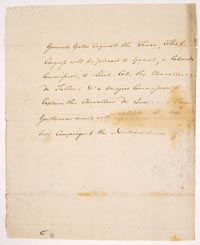 |
Gates, Horatio (1727-1806) British soldier who served in North America during the French and Indian War and became a general in the Continental Army. He claimed victory at Saratoga (1777) and was involved in the Conway Cabal; he was relieved of his command and his conduct was questioned after the Battle of Camden (1780); in 1782 he was allowed back into service under Washington. Autograph Document Signed in the text, one page, 9¼ x 7½ inches, n.p., n.d. "General Gates Requests the Favor, That Congress will be please to grant, a Colonels Commission, to Lieut. Col. the Chevallier de Fallie; & a Majors Commission to Captain the Chevallier de Luce. These gentlemen served with reputation all the last campaign to the Northward." The campaign mentioned is most probably the Saratoga episode as it was about the only time Gates was successfully in command. Three words of text are very faint, not affecting "General Gates."
Estimated Value $600 - 800,
Joe Rubinfine, 1981,
View details and enlarged photo
| Realized
$480 |
Lot 102 |
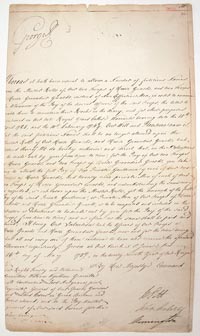 |
George III and William Pitt the Younger, Document Signed ("George R") at top left and ("W Pitt") at bottom right, one page, 18½ x 10¾ inches, Court of St. James, May 16, 1784. To William Wyndham Grenville and Constantine Lord Mulgrave, joint Paymasters General, changing a regulation which had been instigated in 1728 by "our late Royal Grand father's Warrants" and which allowed "a Number of fictitious Names upon the Muster Rolls of our two Troops of Horse Guards, and two Troops of Horse Grenadier Guards…in order to encrease [th]e allowance of the pay of the several Officers of the said Troops, the better to [en]able them to maintain their Ranks in the Army…." Red pencil "XIV" at top right, page seemingly taken from a ledger with several letters of text lacking down left margin; light soiling; small edge splits at horizontal fold. Both signatures are bold.
Estimated Value $600 - 800,
Goodspeeds, 1974,
View details and enlarged photo
| Realized
$630 |
Lot 103 |
 |
Greene, Nathanael (1742-86) American Revolutionary officer; quartermaster general; president of Major André's court-martial trial; he succeeded Gates as commander in the South. Autograph Letter Signed ("N Greene"), one page, 7½ x 6¼ inches, n.p., n.d. (c. 1776-80). To Col. (Clement) Biddle (1740-1814) who was appointed Greene's volunteer aide-de-camp (1776), and who was also commissary general of forage (1777-80) under Greene. "Dear Sir I beg youl excuse me from dining with you. I have got a great deal of writing to do this afternoon; and feel too loaded and oppressed with difficulties to enjoy society. I am with esteem & affection Yours N Greene." There is a faint stain under Greene's signature; otherwise, the letter is boldly penned and signed. Integral address leaf is addressed to Col. Biddle in Greene's hand. Both men were from Quaker families. After Washington, Greene was the most highly-regarded general in the Continental Army.
Estimated Value $1,500 - 2,500,
Joe Rubinfine, 1979,
View details and enlarged photo
| Realized
$2,520 |
Lot 104 |
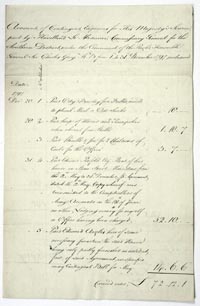 |
Grey, Charles (1729-1807) British general who served in the Seven Years War, the American War of Independence and the French Revolutionary War; 1st Earl Grey. In 1777 he earned the nickname "No-flint Grey" after the Paoli Massacre nighttime attack, because he had collected flints from the muskets of his troops before they engaged the American troops using bayonets, thus maintaining the element of surprise. His son was the Prime Minister Charles Grey, 2nd Earl Grey. Manuscript Document Signed as General Commanding the Southern District, two pages, 12¼ x 7¾ inches, Maidstone, Jan. 4, 1798. "Account of Contingent Expences for His Majesty's Service…from 1st to 31st December 1797…." fine condition. Grey's signature is bold.
Estimated Value $400 - 600,
Goodspeeds, 1966,
View details and enlarged photo
| Realized
$240 |
Lot 105 |
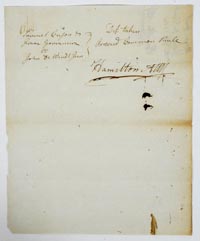 |
Hamilton, Alexander (1755 - 1804) Founding Father; secretary and aide-de-camp to Washington; member of the Continental Congress; one of three authors of the Federalist; signer of the U.S. Constitution; 1st U.S. Secretary of the Treasury; leader of the Federalists. Killed by Aaron Burr in a duel. Autograph Document Signed ("Hamilton Atty"), and docketed on the verso in his hand (Hamilton Atty"), ½ page. 9 x 7½ inches, "Mayor's Court" (New York City), December 7, 1784. Hamilton's "Dogget" for that day relates that his case, "Samuel Cuson vs Isaac Governeur vs John de Winds, Jun" was ordered "Common Rule." Large signatures with paraphs. Written the same year Hamilton founded the Bank of New York, the oldest on-going banking organization in the United States. Hamilton, who was admitted to the New York Bar in July 1783, specialized in defending Tories and British subjects, including those whose property had been damaged during the military occupation of New York.
Estimated Value $800 - 1,000
View details and enlarged photo
| Realized
$720 |
Lot 106 |
 |
Hancock, John (1737-93) Signer of the Declaration of Independence; President of the Continental Congress; Governor of Massachusetts. Autograph Document Signed ("Jno. Hancock"), 2 x 7½ inches, n.p., Dec. 24, 1757. Two lines acknowledging receipt of "Thirty pounds three shillings & two pence in part of within by the Hands of Mr. Joseph Hull." Written on the verso of a partly-printed documented with the name of his wealthy uncle, Thomas Hancock, whose estate John would inherit in 1764. One taped repair on verso, running horizontally between the two lines of text, not affecting Hancock's signature.
Estimated Value $2,500 - 3,500,
Joe Rubinfine, 1979,
View details and enlarged photo
| Realized
$1,680 |
Lot 107 |
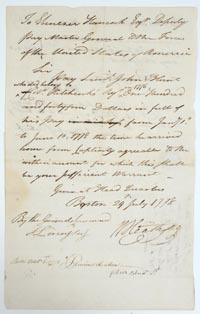 |
Heath, William (1737-1814) Revolutionary War officer; promoted to major general in 1776; reprimanded by Washington for his handling of the attack on Fort Independence in 1777; commanded the Eastern Division (1777-79) and in the Hudson Valley (1779-81). Manuscript Document Signed ("W Heath MG"), one page, 12 x 7½ inches, Boston, July 29, 1778. Ordering Ebenezer Hancock to pay Lt. John Blunt $144 due him for the time he was in captivity. Attached to verso is a true copy of a notarized statement from Brig. Gen. John Nixon certifying that Blunt was in Col. Hitchcock's Regt, in Nixon's Brigade in 1776 "and was taken prisoner on Long Island 27th Aug.t 1776."
Estimated Value $500 - 600,
Goodspeeds, 1969,
View details and enlarged photo
| Realized
$990 |
Lot 108 |
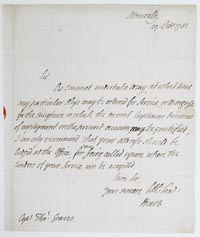 |
Howe, Richard, 1st Earl Howe (1726-99) Admiral of the British fleet during the American Revolution; known as "Black Dick." With his brother, William Howe, who commanded British land forces, he attempted a reconciliation with the Americans. When a new peace commission was appointed in 1778, he resigned his commission and would not accept another command until March 1782 when North's government fell. Howe was one of the most famous Admirals in British history. Military historians consider his 1794 victory over the French at The Battle of the Glorious First of June ranks with Quiberon Bay, The Nile, Trafalgar, Jutland, and probably the Spanish Armada.
Autograph Letter Signed ("Howe") as Admiral, one page, 9½ x 8 inches, Admiralty, Oct. 29, 1781. Ten days after Cornwallis' surrender at Yorktown, Howe writes to Capt. Thomas Graves: "As I cannot undertake to say, at what time any particular ship may be ordered for service, or to engage for the succession in which the several Captains desirous of employment on the present occasion may be gratified; I can only recommend that your address should be lodged at the Office, for your being called upon when the tenders of your Service can be accepted…." Fine.
Estimated Value $1,000 - 1,250,
Mary Benjamin, 1979,
View details and enlarged photo
| Realized
$582 |
Lot 109 |
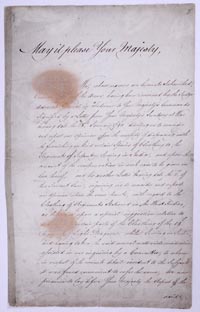 |
Howe, William, 5th Viscount Howe (1729-1814) British commander-in-chief during the American Revolution. He resigned his command in 1778 and returned to England. Manuscript Document Signed by Howe ("W Howe"), two pages, 13 x 8 inches, Horse Guards (England), June 8, 1790. Signed with 25 other British Army generals, responding to a command from George III, issued Jan. 28, 1790, directing them to give their opinion "upon the necessity of dispensing with the furnishing in kind certain Species of Cloathing to the Regiments of Infantry in India…." They were also to report the same for troops in the West Indies and for a regiment of Light Dragoons in India. The document with recommendations is not present but this document has the signatures of the 26 generals in two columns on the verso. Another name which stands out, in addition to Howe, is that of James Murray, who was one of Wolfe's Brigadiers at Quebec during the French and Indian War. More research on the other generals would add value to this document. Tape reinforcement at one edge and one small fold repair; first page is soiled; two discolored areas affect a few words of text and two signatures, not including Howe's.
Estimated Value $400 - 600,
Purchase date: July 2, 1968,
View details and enlarged photos
| Realized
$840 |
Lot 110 |
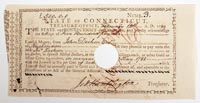 |
Huntington, Jedediah (1743-1818) American Revolutionary War officer. Partly-printed Document Signed as Treasurer of Connecticut, 3¾ x 7¾ inches, Feb. 18, 1789. Acknowledging receipt of 500 pounds from John Deshon, whom the state promises to pay in Spanish milled dollars "or other Gold or Silver Coins equivalent" at interest of 6% per annum. Signature is affected by a written vertical cancellation. Fine.
Estimated Value $100 - 150
View details and enlarged photo
| Unsold |
Lot 111 |
 |
Jay, John (1745 - 1829) American patriot; first Chief Justice of the United States. Autograph document signed, with his name written twice more in the body of the document, one page, 4½ x 7½ inches, Bedford, 31 Aug. 31, 1792. Also signed by Samuel Lyon. A settlement of accounts between Jay and Lyon delineating monies owed to Jay by Lyon and the method of payment for the balance due. Lyon served as a major of Westchester County minute men during the Revolution. The laid, watermarked paper is evenly toned. Boldly penned and signed by Jay.
Estimated Value $1,800 - 2,200
View details and enlarged photo
| Unsold |
Lot 112 |
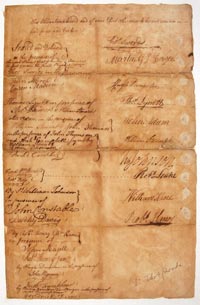 |
Johnson, Sir William (1715-74) British colonial official who settled in New York's Mohawk Valley and became wealthy from the fur trade land and purchasing land from the Indians; superintendent of Indian affairs; major general in French and Indian War; Loyalist in the American Revolution. Manuscript Document signed by Sir William Johnson and several other officers, two pages, 12¼ x 7½ inches, New York, Dec. 20, 1769. The document relates to a lawsuit between several citizens of New York and a dispute of boundary lines between Albany and Ulster, New York. Some of the parties named who signed on the third page include Thomas Swords, Marten Garretson Van Bergen, Hugh Deniston, Thomas Lynott, William Kane, Robert Henry, Sir William Johnson, and several others.
At the conclusion of the Seven Years War, the British Government did not want to pay to support thousands of soldiers in Ireland, England and America. They encouraged the resignations of their soldiers and, as incentive, promised 2000 acres of wild land in America and half salary to each man who gave his notice. To get around the prohibition on granting more than 2000 acres of land to a single individual, Sir William used a variety of devices, one being to set up a dummy "partnership" of twenty people to purchase 20,000 acres of land from the Indians.
This document reflects an ejectment case. These suits were brought on behalf of a fictitious current tenant, often called "James Jackson," as is the case here. The parties above have bonded famed surveyor and map maker William Cockburn to represent their claims before the Superior Court. Archival linen applied, older repairs, age toned, and signature page is inlaid. Signatures are bold and well struck; in overall very good shape.
Estimated Value $1,500 - 2,000
View details and enlarged photos
| Realized
$1,020 |
Lot 113 |
 |
Knox, Henry (1750-1806) American Revolutionary War officer; close friend and advisor of Washington, whom he succeeded as commander of the Army; first U.S. Secretary of War; founder and first secretary of the Society of the Cincinnati. Autograph Document Signed ("H. Knox"), 3¼ x 8 inches, n.p., Nov. 23, 1797. "Mr. Davenport will please to give Capt Andrew Malcom the order for the five hundred bushels of corn." Very good; toning and some contemporary ink smears.
Estimated Value $500 - 600,
Goodspeeds, 1965,
View details and enlarged photo
| Realized
$300 |
Lot 114 |
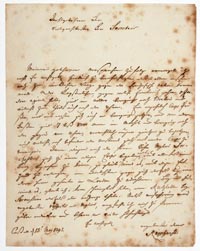 |
Knyphausen, Wilhelm von (1716-1800) Prussian officer with many years of military experience who went to America in 1776 to be second in command of the Hessian troops fighting with the British. After General Leopold von Heister was recalled in 1777, Knyphausen took command of the Hessians, leading them at Brandywine, Fort Washington, White Plains, Germantown, Springfield, and Monmouth. He was in command of New York City during William Howe's temporary absence in 1780. He was considered the consummate professional soldier, respected by friend and foe. In May 1782, he returned home and was appointed military governor of Kassel by Prince Friedrich II. Autograph Letter Signed ("Knyphausen"), one page, 9¾ x 7¾, in German, untranslated, May 13, 1792. With integral docket leaf. Overall toning and foxing; letter was silked years ago for conservation. Boldly penned and signed.
Estimated Value $1,000 - 1,500,
Mary Benjamin, 1979,
View details and enlarged photo
| Realized
$630 |
Lot 115 |
 |
Kosciuszko, Tadeusz (1746-1817) Polish-Lithuanian military officer who fought in the American Revolution from 1776-83. His services as an engineer were important to the American victory at Saratoga; he served in the Southern Department with General Gates and was chief engineer to Gates' successor, General Nathanael Greene. In 1783 Congress promoted him to brigadier general for his services and made him an American citizen. He was a charter member of the Society of the Cincinnati. Autograph Letter Signed in the text ("Le General Kosciuszko"), in French, 3½ x 7¼ inches, n.p., n.d. Kosciuszko graciously thanks Lord Carnarvon for his goodness in intervening on his behalf with His Excellency the Duke of Portland and begs Lord Carnarvon to accept his deepest gratitude and appreciation. Mounting remnants on margins of verso, else fine.
Estimated Value $1,500 - 2,000
View details and enlarged photo
| Realized
$2,880 |
Lot 116 |
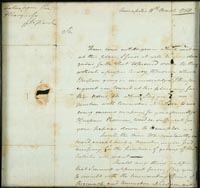 |
Lafayette - Marie-Joseph Paul Yves Roch Gilbert du Motier, Marquis de La Fayette (1757-1834) French statesman and soldier; major general in the American Continental army and a close friend of George Washington. Manuscript Letter Signed ("Lafayette"), 1¼ pages, 9½ x 10 inches, Annapolis, March 10, 1781. With orders to Colonel (Joseph) Vose (1738-1816) of the First Massachusetts, one of his unit commanders (who would become a charter member of the Society of the Cincinnati). The paper is toned with small holes and separations along the folds, affecting only a few letters. Housed in an 11 x 11¼ inch double-sided frame. Revolutionary War-date letters from Lafayette are rare. Orders for the transportation of troops by water, rather than by foot or horse, are unusual.
In full: "From some intelligence which met me at this place, I find it will be very dangerous, for the Fleet to proceed down the Bay, without a proper Convoy….I therefore request you, to wait at this place my further orders, till which I beg you in conjunction with Commodore (James) Nicholson, to use every means necessary, for your security & to prepare Provisions, wood, &c. sufficient for your passage down to Hampton. I wish the men to be constantly on board, except such a number, as you find necessary, for the purpose of getting off the Articles you want. Should any thing happen that I cannot at present foresee, I beg you to consult with the commanding officers of Regiments, and Commodore Nicholson and take such steps as you, and they may find necessary. I have the honor to be with esteem your humble servt. Lafayette."
In January 1781, Benedict Arnold, now a British brigadier general, was wreaking havoc along the James River and Hampton Roads port towns and Governor Thomas Jefferson appealed to General Washington. In February 1781, Washington ordered Lafayette south with a force of some 1,200 New England and New Jersey troops. They were to be complemented by 1200 French troops, which were to be taken to Virginia by the French naval squadron. Lafayette and his force arrived at Head of Elk (Elkton, MD) on March 3, but there were not enough boats for his men to proceed down river. On March 8 Lafayette moved his men to Plum's Point and Cecil's Ferry while he went on ahead of his troops to Annapolis, then took a barge and proceeded further down the Bay with the intention of meeting von Steuben in Virginia. French Admiral Destouches, with 1,100 grenadiers and chasseurs under Baron de Vioménil, Rochambeau's second in command, departed Newport, RI, for Virginia waters, followed soon thereafter by a British fleet, which managed to get ahead of the French and gain possession of the Chesapeake. On March 10, Lafayette wrote this letter to Col. Joseph Vose, with orders to prepare for their trip south. Lafayette's Virginia Campaign, which involved months of encounters and engagements with the British, contributed to Washington's decision to face the British in the South rather than New York and served as a prelude to the Yorktown Campaign, which resulted in the surrender of Cornwallis and the beginning of negotiations between the United States and Great Britain to end the war.
This letter was acquired by the consignor in 1970 from a Massachusetts neighbor who found it in the attic of the house where the family had lived for genernations. The consignor took it to Goodspeeds in Boston to ascertain a fair purchase price. Lafayette war-date orders are rare.
Estimated Value $4,000 - 6,000
View details and enlarged photos
| Realized
$9,900 |
Lot 117 |
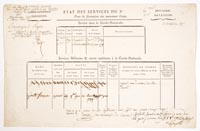 |
Lafayette, Marquis de, Partly-printed Document Signed ("Lafayette"), one page, 8¼ x 13 inches, Paris, Oct. 6, 1791. As head of the Parisian National Guard during the early years of the French Revolution, Lafayette certifies the signature and record of a soldier who had served in the National Guard and the French Guard. The soldier had served in the 6th Division, 1st Battalion, and had obtained the ranks of sergeant and 2nd Lt. He had been wounded in the right arm. This document was part of the registry for the formation of new Corps in the National Guard. Lafayette signed at lower right. Fine condition.
Estimated Value $600 - 800
View details and enlarged photo
| Realized
$870 |
Lot 118 |
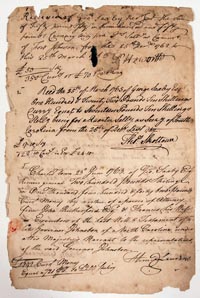 |
Laurens, Henry, Autograph Document Signed, one half of 12 x 8 inch page, Charles Town, June 23, 1763. Laurens signs in receipt of monies paid by George Saxby, the king's receiver general: "…Two hundred pounds sterling, in One Thousand four hundred & forty two pounds Curr[en]t money by virtue of a power of Attorney from John Rutherford Esqr & Frances his wife as Executors of the last will & Testament of the late Governor Johnston of North Carolina under His Majesty's Warrant to the representatives of the said Governor Johnston…" Toned, some show-through, and ragged edges, not affecting Laurens' text or signature, which are boldly penned and signed. This seems to be a page from a ledger since the two sides have four other notations (signed by other people) of payments received from George Saxby.
Estimated Value $1,000 - 1,250,
Superior Galleries, 1993,
View details and enlarged photos
| Realized
$600 |
Lot 119 |
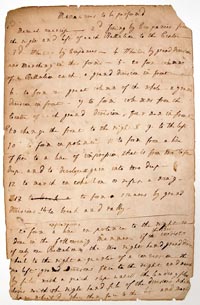 |
Lee, Charles (1731-82) British-born officer in the Continental Army. Appointed the second-ranking major general, he criticized Washington and was slow to follow orders. He was captured by the British in 1776 and, while a prisoner, gave Gen. Howe a plan to defeat the Americans. He was exchanged in 1778. After the Battle of Monmouth, he was court-martialed and suspended from command; he was dismissed from the Army in 1780. Autograph Manuscript, 1½ pages, 13 x 8¼ inches, n.p., n.d. Headed "Maneuvres to be perform'd," beginning "Manual excercise--2d firing by Companies from the right and left of each Battalion to the Center. 3d - Wheeling by companies. 4 Wheeling by grand divisions and marching in this form. 5 - to form columns of a Battalion each, a grand division in front…." He continues with nine other listed items, then draws a line, writes, "explanation, to form a line…to the right is done in the following manner - if the body consists of only one Battalion, the two right hand grand divisions wheel to the right a quarter of a conversion - the two left grand divisions face to the right and march by file with a quick step…." and so on. Several words are crossed out. These instructions are believed to have been written by Lee before the Siege of Boston to instruct commanders who had never had any formal military training. Toned with several edge chips; paper loss at top right corner affects three or four words of text.
Estimated Value $1,000 - 1,500,
Goodspeeds, 1965,
View details and enlarged photos
| Realized
$2,520 |
Lot 120 |
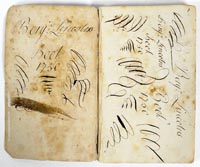 |
Lincoln, Benjamin (1733-1810) Major General in the Continental Army; he accepted the British surrender at Yorktown. He was present at the three major surrenders of the Revolutionary War, twice as a victor (Saratoga and Yorktown) and once as the loser (Charleston). He was the first Secretary of War (1781-83) and headed the militia that put down Shays' Rebellion (1787). He was Lt. Gov. of Massachusetts from 1788-89 and was appointed by Washinton to be the first collector of the port of Boston (1789-1809).
Autograph Manuscript Signed three times ("Benj:a Lincolns Book 1750"), This is Benjamin Lincoln's geography copy book, used by him at the age of 16-17. This little book has covers of marbled card with all of the 114 full pages in the very neat hand of the teenage Benjamin Lincoln. On each page of this amazing relic, Benjamin has described a country or an American state. On pages 101 and 102 he puts forth the the attributes of Virginia and Carolina which reads in part: "Virginia- Its bounded East by ye Main Ocean West by some of Terra Sectia North by Maryland and South by Carolina. The air as to Heat & Cold Dryness & Moisture is varibal according to ye Winds…The soil is generally Sandy, yet abundantly fertile in grain. The chief commodities are Tobacco and Deer Skins bever & other Wild Beasts…Its Governed by a Governor Appointed by ye Britannick Majesty. Religion Protestant…" Lincoln later obtained a Master's degree from Harvard.
Estimated Value $800 - 1,000
View details and enlarged photos
| Realized
$1,320 |
Lot 121 |
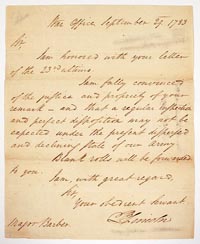 |
Lincoln, Benjamin, Manuscript Letter Signed ("B Lincoln") as Secretary of War, one page, 9 x 7¼ inches, War Office, Sept. 29, 1783. To Major Barber, in part: "…I am fully convinced of the justice and propriety of your remark--and that a regular inspection and perfect disposition may not be expected under the present dispersed and declining state of our Army. Blank rolls will be forwarded to you…" Very fine.
Estimated Value $300 - 500,
Goodspeeds, 1968,
View details and enlarged photo
| Realized
$480 |
Lot 122 |
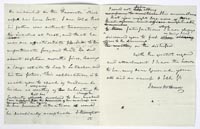 |
McHenry, James (1753-1816) Revolutionary soldier and surgeon; aide to Washington; signer of the U.S. Constitution; Secretary of War (1796-1800). Fort McHenry in Baltimore is named after him. Autograph Letter Signed, three-page draft, Princetown, Aug. 18, 1783. To "My Dear General" (Washington) regarding the fate of the widow of a French soldier who had served in the American Revolution:
In part: "My Dear General, I am going to receive your thanks for putting it in your power to do good. A Miss Howard, a citizen of Annapolis, of an amicable character and reputable connections married a Cap.n Le Vacher de Vanbrun, a French gentleman. The Cap.n served with reputation in our army from the year 1776 till the capture of Lord Cornwallis when he obtained a furlough to visit France. He embarked on the Favorite which vessel has been lost. I am told that his father …died about eighteen months since, leaving a large estate to Capn Le Vacher and his two sisters. This application is to enable you to speak of Madam Le Vacher as every way worthy of inheriting the property that is devolved to her husband….With the greatest regard and attachment I have the honor to be, my dear General, your old aid de camp & hbl. svt. " Boldly penned and signed, with numerous holograph corrections. Although the general to whom McHenry writes is not named, the fact that McHenry refers to himself as "your old aid de camp" leaves little doubt that he is writing to General George Washington.
Estimated Value $1,000 - 1,250
View details and enlarged photo
| Realized
$1,200 |
Lot 123 |
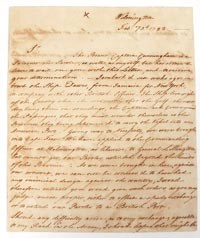 |
Montagu, Lord Charles Greville - 1783 Letter From An Imprisoned Former South Carolina Colonial Governor, Autograph Letter Signed "Charles Montague" as Lt. Col. Commanding, two pages, 9 x 77½ inches, written from prison in Wilmington, South Carolina, Feb. 3, 1783. Pleading for release as it was only by chance that his ship, the Dawes, bound from Jamaica for New York [still mostly a Loyalist colony] had lost sight of the convoy and the captain and crew had announced to the passengers that they should consider themselves their prisoners. "We have applied to the Commanding Officer at Wilmington, as likewise to General Lillington [Alexander Lillington, a British subject turned American Patriot, past friend of Montagu ] but cannot get our paroles extended beyond the limits of this Province…." Montagu asks that if his own rank the army prevents his parole, he hopes it will be granted to his son and other officers. Lord Montagu arrived in New York on April 4, 1783. Fine; museum quality linen archiving to letter.
Lord Charles Greville Montagu (1741-84) was the last colonial governor of South Carolina (1766-73). During the Revolution, he obtained a commission in Jamaica where he would not serve against the Americans. He owned 18,000 acres of land in South Carolina and remained friends with several prominent South Carolina families after the war. He and many of his men settled in Halifax, Nova Scotia. A scarce Revolutionary War letter from the last South Carolina Colonial Governor.
Estimated Value $400 - 600
View details and enlarged photo
| Unsold |
Lot 124 |
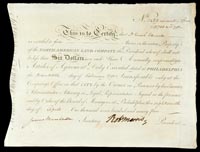 |
Morris, Robert, Partly-printed Document Signed ("Robt Morris") as president of the North American Land Company, 9½ x 12½ inches, Philadelphia, April 18, 1795. Certificate No. 1489 for five shares in the company to Dr. Enoch Edwards. Erosion in two letters of signature from the iron gall ink used by Morris. Countersigned by James Marshall as secretary. Laid watermarked paper with attractive scallopped left edge. Three years later Morris would land in debtors' prison because of his unfortunate land speculations. A sad end for the "financier of the Revolution."
Estimated Value $700 - 900
View details and enlarged photo
| Realized
$660 |
Lot 125 |
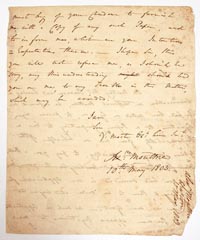 |
Moultrie, William (1730-1805) American Revolutionary War officer; Governor of South Carolina; namesake of Fort Moultrie. Autograph Letter Signed ("W:m Moultrie"), two pages, 9¾, n.p., May 10, 1803. To an unknown correspondent, in part: "On meeting Mr. Penman…he inform'd me he had been called on by you, to prove my signature to a Paper, purporting to be a Responsibility from me…to pay you a Debt due from the late Mr. Washington to you…must beg of you…to furnish me with a Copy of any such Paper…this you will not refuse me, as I should be sorry, any Misunderstanding should lead you or me, to any Trouble in this matter, which may be avoided…." Small paper loss in lower left corner affects two words.
Estimated Value $400 - 600,
Goodspeeds, 1966,
View details and enlarged photos
| Realized
$240 |
Lot 126 |
 |
Otis, Samuel (1740-1814) Revolutionary War quartermaster of the Continental army; speaker of the Massachusetts house of representatives, member of Congress under the Articles of Confederation, and first secretary of the U.S. Senate. Document Signed ("Sam: Otis") three times, once in full in the text, once at the bottom and once on the verso, two pages, Boston, May 6, 1765. Otis declares that he rented a cellar in 1763 and a store in 1764 from a Mr. Wheelwright but the rents are being demanded by two other men and he doesn't know whom to pay. Some questions and answers on the verso settle the question and Otis signs that he paid Mr. Wheelwright. Very good; toned with scattered foxing.
Estimated Value $250 - 350
View details and enlarged photo
| Realized
$180 |
Lot 127 |
 |
Parsons, Samuel H (1737-89) American Revolutionary War officer. He was actively involved in promoting resistance to the British and was an early proponent of a congress of the colonies. He served from the Lexington Alarm in 1775 until after the British surrender at Yorktown. Revolutionary War-date Autograph Letter Signed ("Saml H. Parsons"), one page, 8½ x 7½ inches, n.p., n.d. (c. 1775). To "Mr. Commisy. Clark / Camp" regarding officers' hats: "The three Hats…are for me & my Family [meaning his aides and other officers in his own headquarters]. I exclude the officers of the 6th Regt. [Parsons was appointed colonel of the 6th Connecticut Regiment in 1775] from a Division except the field officers because their Caps make them decent in appearance & if they want, they must wait. Two of the field officers of the 5th Regt. have had their share to one; the Paymaster also has been supplied & therefore that Regt. ought to be excluded from a Draft for the three remaining on Hand, as the Regts. who draw them can have no more than the 5th have had…" When the regimental commander gets involved with what to do with three hats, it shows the scarcity of clothing.
Estimated Value $600 - 800,
Mary Benjamin, 1981,
View details and enlarged photo
| Realized
$600 |
Lot 128 |
 |
[Passaic, New Jersey] 1709 Land Grant Signed by Four Native Americans, An early land grant encompassing a major portion of Passaic, New Jersey signed by four Native Americans with their totem signatures; two pages, 13 x 8¼ inches, September 28, 1709. To the widow Rachell Bayard, in part:
"Know all men by these presents that Woo Naghpoint, Tathoghharout, Passihohap, Kangoran, and Muklas the native Indian proprietors of sundry tracts of land in the Eastern division of New Jersey, for a valuable consideration to us in hand paid…in consideration of the sum of five shillings current money of New York…paid by Rachell the widow…of Petrus Bayard…do grant…unto the said Rachell Bayard her heirs and assigns forever All that certain piece or parcel of land in the said Eastern division of New Jersey situate lying or being upon Pasaick beginning below the great falls Arassondegaat called Sorhomork by the native Indians running from Pasaick river west till it meet with a fall Wissekagh-same and thence north up the said fall till it meet with a certain foot path and marked trees and thence South to Pasaick river containing about two or three hundred acres. New York, this twenty-eighth day of September Anno Domini 1709…" Even toning, some professional repairs, reddish stains at right edge, not affecting the boldly penned text.
Estimated Value $2,000 - 3,000
View details and enlarged photos
| Realized
$2,880 |
Lot 129 |
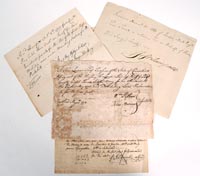 |
[Revolutionary War], Lot of four documents: Jonathan Trumbull (1710-85) Governor of Connecticut (1769-84); called "Brother Jonathan" and "the first of the patriots" by George Washington. Autograph Document Signed ("Jon;th Trumble"), two pages, 11¾ x 7¼ inches, Lebanon (CT), Jan. 16, 1764. To Joseph Talcot, Treasurer of the Colony of Connecticut with a list of "People to Abate" to the constable, showing what they owe. Most of them "are poor, have nothing whereon to Levy & Collect the money, & may be com[m]itted to prison, which will only prove chargeable…." A large "X" affects three letters of Trumble's last name, which was soon changed for unknown reasons to "Trumbull." Fine.
Joseph Bloomfield (1753-1823) Officer in both the American Revolution and the War of 1812; Governor of New Jersey (1801-1812). Manuscript Document Signed ("Jos: Bloomfield"), one page, 7¼ x 8¼ inches, n.p., Dec. 11, 1781. A receipt for a £3 retaining fee "in Behalf of the West Jersey Society." Fine.
Titus Hosmer (1736-1780) Delegate to the Continental Congress; he signed the Articles of Confederation. Document Signed, one page, 6¼ x 7¾ inches, Hartford, May 15, 1778. Ordering John Lawrence, treasurer of Connecticut, to pay eight pounds to Lynde Lord, the sheriff of Litchfield for his attendance at the election of May 1778. Countersigned by William Pitkin. Areas of dark, uneven toning.
Lt. Col. Hezekiah Wyllys. Document Signed, 6¼ x 7½ inches, Hartford, Oct. 8, 1777. Wyllys acknowledges receipt for Col. Roger Newberry from the Pay Table Committee payment of one hundred pounds "for the use of the first Regt. Militia now under Marching Orders for the Peekskill." Fine.
Estimated Value $500 - 600
View details and enlarged photo
| Realized
$384 |
Lot 130 |
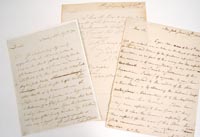 |
[Revolutionary War Officers & Aides-de-Camp] Clarkson, Humphreys & Mercer, Matthew Clarkson (1758-1825) Aide-de camp to Benedict Arnold. He was at Saratoga and later on the staff of General Benjamin Lincoln; he was present at Yorktown. Autograph Letter Signed ("M. Clarkson"), one page, 10 x 7¾ inches, New York, June 24, 1800. To Governor John Jay, regarding a $500 order sent to Clarkson on the Bank of New York in 1798. Clarkson would like to pass the money to the credit of the state as, "I have been a long time expecting to hear from Mr. King in order to close the business respecting the Arms imported for the use of this State…." Fine.
David Humphreys (1752-1818) Aide-de-camp, friend and confidant to George Washington, who entrusted him with carrying the surrended British standard from Yorktown to the Congress in Philadelphia. War of 1812-date Autograph Letter Signed ("D. Humphreys"), one page, 10¾ x 8 inches, Humphreysville (now Seymour, CT), July 17, 1813. To Gen. Eben[ezer] Huntington, enclosing "the result of the Election of Officers in the Humphreysville Compy of Volunteer Exempts, & request that Commissions may be issued accordingly." [list not present]. Very good; toned around edges; one tear in lower right margin affects nothing.
John Francis Mercer (1759-1821) Aide-de-camp to General Charles Lee; resigned after Lee's court martial; reentered Virginia militia; served briefly under Lafayette in Virginia and was at Yorktown. He was Governor of Maryland (1801-03). Autograph Letter Signed as U.S. Representative from Maryland, one page, 9 x 7 inches, Strawberry Hill, Aug. 31, 1792. To a man in Baltimore regarding some hearths of "Dark Country Marble" which Mercer wanted to purchase. Inlaid, else fine.
Estimated Value $500 - 750
View details and enlarged photo
| Realized
$720 |
Lot 131 |
 |
[Revolutionary War] Officers Who Became Governors, John Eager Howard (1752-1827) Commanded the 3rd Maryland Regiment of the Continental Line at the important battle of Cowpens, Jan. 17, 1781, for which he won a medal from Congress. He became Governor of Maryland (1788-91). Manuscript Letter Signed ("J.E. Howard"), one page, 8¾ x 7¼ inches, In Council, Jan. 26, 1790. To Thomas Harwood, Treasurer of the W. Shore, asking for a list of the state's public debtors, so that methods could be considered for collecting those debts. Old fold repairs on verso, else fine.
Isaac Shelby (1750-1826) Hero of King's Mountain (with John Sevier); 1st Governor of Kentucky. Manuscript Document Signed, 9 x 7½ inches, one page, n.p., Sept. 4, 1783. A bond between Shelby, Robert Carr and William Crow for "Forty five pounds Virginia money." Very good; normal folds and toning.
Richard Howell (1754-1802) Officer in the 2nd New Jersey Regiment (1775-79); 3rd Governor of New Jersey (1794-1801). Partly-printed Document Signed as Governor, 8 x 13½ inches, Trenton, Aug. 7, 1798. Allowing the Last Will and Testament of Phebe W. Wade, deceased, and granting the administration of the Will to her executors. Attractive seal at upper left. Light toning; old note in lower margin.
Estimated Value $500 - 600
View details and enlarged photo
| Realized
$300 |
|
|